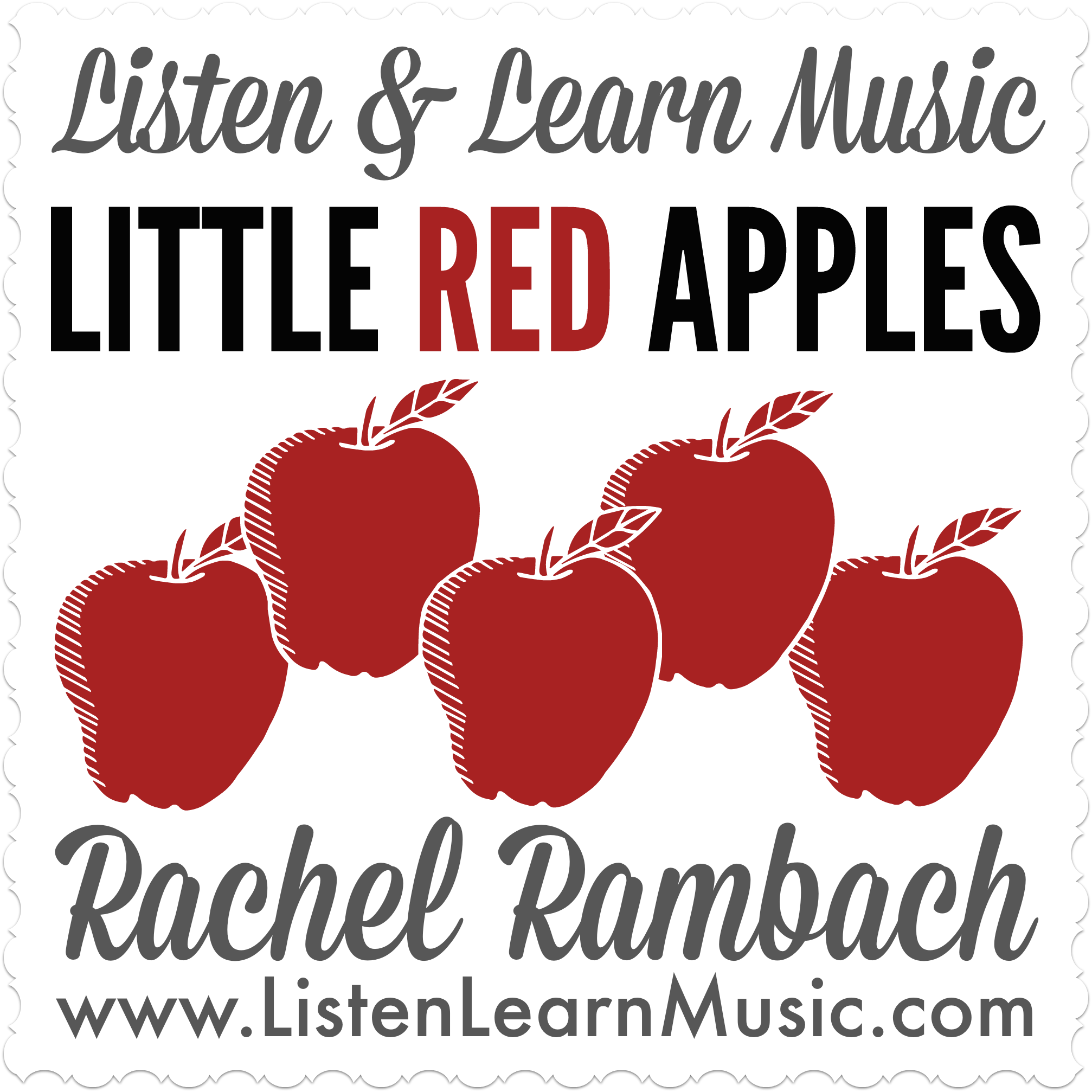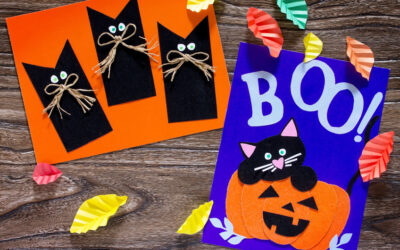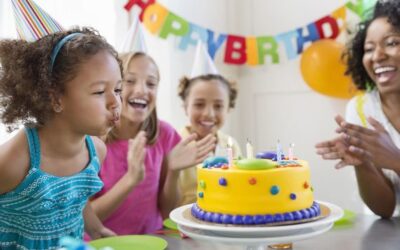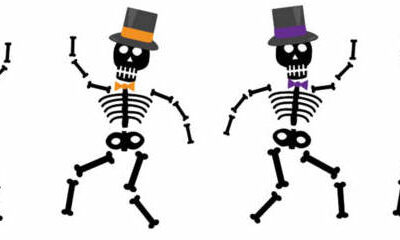Free Download: “Little Red Apples”
This is one of many counting songs I’ve written, which focuses on counting both up to 5 and down from 5. I created simple apple visual aides (using red construction paper and then laminating) which my students can then manipulate as we count.
Click here to download the mp3 and lyrics/chords.
P.S. If you want access to my entire collection of over 200 songs (mp3, lead sheet, and instrumental track), videos, tutorials, and visual aides, plus ALL new releases from Listen & Learn Music, consider joining me over at Listen & Learn Plus!
Friday Fave: Halloween!
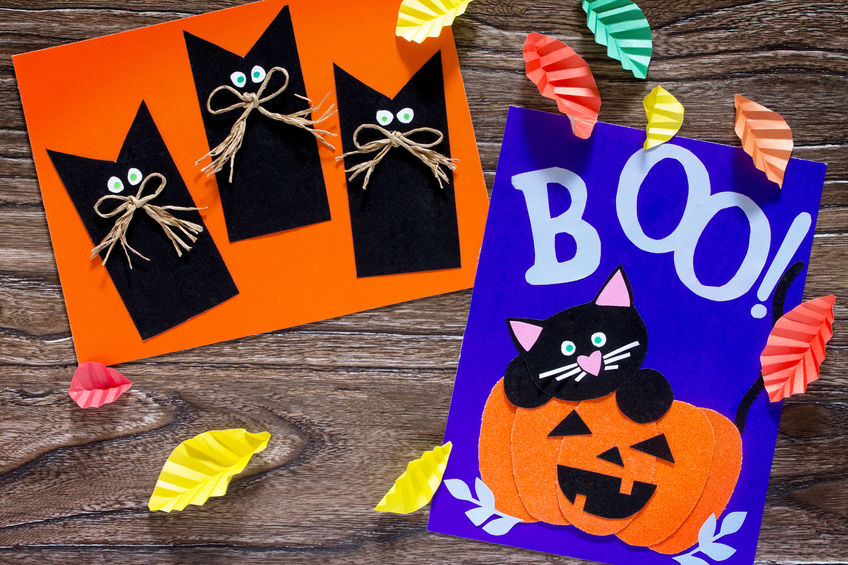
Coming down with the flu can really set a girl back, you know? I’ve spent the last two days catching up on the work I should have been doing on Monday, Tuesday, and Wednesday, when instead, I was laying in bed with a fever, cough, and headache. But thankfully, I am all better now and ready to take on this busy weekend!
And that includes, of course, HALLOWEEN. So in celebration of the spookiest day of the year, today’s Friday Fave is dedicated to dressing up, trick-or-treating, and scarfing down candy. I will be doing all of the above tomorrow at a friend’s costume party…what about you? Do you have any big Halloween day plans?
Oh, I also have to tell you that two of my students won our paper’s local costume contest and were featured on the front page of the State Journal-Register today! Take a look at these cute little slices of pizza:
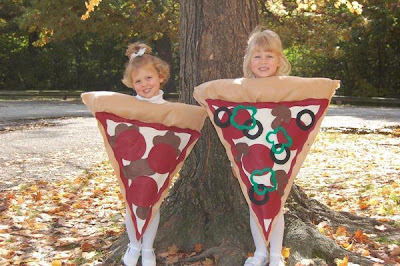 Adorable, right? The girls’ mom made those costumes, and their win was well-deserved :) What are your little ones going as? I had so much fun looking at all of my students’ costumes at school today, from cheerleaders to jailbirds and everything in between.
Adorable, right? The girls’ mom made those costumes, and their win was well-deserved :) What are your little ones going as? I had so much fun looking at all of my students’ costumes at school today, from cheerleaders to jailbirds and everything in between.
Enjoy your Halloween; stay safe and have fun! Here’s a little tune to hum as you go to door-to-door with your little ghost or goblin.
Do you know about a day
That’s not so very far away
Everywhere there’s orange and black
And chills are running up your back.
Jack-o-lanterns and ghosts and bats,
Witches and goblins and big black cats
Spooky spooks come out to play
On the thirty-first, Halloween Day.
Let’s pick a costume we can wear
And all the neighbors, we will scare
When at their door we trick or treat
And they will give us something sweet.
Jack-o-lanterns and ghosts and bats,
Witches and goblins and big black cats
Spooky spooks come out to play
On the thirty-first, Halloween Day.
Shapes are Everywhere
 Shape identification is a skill I’ve addressed through music with countless students, and I think I’ve also lost count of the songs and activities I’ve used for this particular goal area. There are plenty of songs out there about shapes, but I decided to write my own so that I could choose which shapes I wanted to include, as well as specific examples of each.
Shape identification is a skill I’ve addressed through music with countless students, and I think I’ve also lost count of the songs and activities I’ve used for this particular goal area. There are plenty of songs out there about shapes, but I decided to write my own so that I could choose which shapes I wanted to include, as well as specific examples of each.
Rectangle, circle, triangle, square,
Find them here and there.
In your house, and outside too,
Shapes are everywhere.
Books and doors and picture frames
Are rectangles, usually.
Two sides are short, two sides are long,
Which rectangles can you see?
CHORUS
Wheels and buttons and lollipops
Are circles, usually.
Circles are round and have no sides,
Which circles can you see?
CHORUS
Slices of pizza, cake, and pie
Are triangles, usually.
Three sides that can be short or long,
Which triangles can you see?
CHORUS
Blocks and cheese and checkerboards
Are squares, usually.
Four sides that are all the same,
Which squares can you see?
CHORUS
See what other objects your students can identify in these four different shapes…I actually had a hard time coming up with a few of them! This song just begs for pictures to accompany it, which would be a great art project. What songs or activities have you used to teach shapes? I’d love to hear your ideas!
State Journal-Register: Lyrical Learning
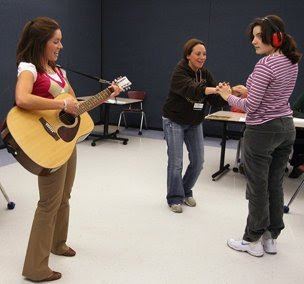 I couldn’t have asked for a better feature about music therapy than the one my local paper published in today’s edition. Many, many thanks to Ann Gorman, who spent the good part of a day interviewing and observing me, and wrote the wonderful article. It is available online, but I also wanted to share it with my Listen & Learn readers right here.
I couldn’t have asked for a better feature about music therapy than the one my local paper published in today’s edition. Many, many thanks to Ann Gorman, who spent the good part of a day interviewing and observing me, and wrote the wonderful article. It is available online, but I also wanted to share it with my Listen & Learn readers right here.
Lyrical Learning:
Music therapist uses songs as teaching aid at Hope Institute
by Ann Gorman, Correspondent
The State Journal-Register
October 26, 2009
Rachel Rambach has a song for almost every occasion or teachable moment, from “Yummy Summer” and “Friendly Words” to “Fall into Fall” and “Under, Over, In and Out.”
The 26-year-old Springfield native has composed more than 100 melodies, using them in her work as a music therapist for the Hope Institute for Children and Families, and in her private practice.
Since 2007, she’s been employed designing and implementing a music therapy program for the Hope Institute. The institute is a nonprofit center that provides educational, residential and health services to people ages 5-21 with multiple developmental and physical disabilities, including cognitive impairment or illness, autism, cerebral palsy, neurological disorders, visual or auditory impairments, ambulatory difficulties and psychiatric or behavior disorders.
“Hands clap, feet tap. It’s time to sing hello./To you and you and you and you, all of the people that we know,” Rambach sang on a recent morning at Hope School Learning Center on East Hazel Dell Road in Springfield.
Grinning broadly, a young man named Ray enthusiastically joined in with Rambach as she strummed her guitar.
“So let’s all come together, and sing out big and strong./Let’s have a good time in music, while we dance and play along,” crooned Ray, who uses a wheelchair.
Other teens in the classroom, all with special needs, chimed in on songs about the weather or calendar, their voices building as they recalled the lyrics.
“The kids really benefit from repetition and hearing the songs a lot – they can sing them by heart and feel really comfortable with them,” Rambach said.
Although some students at first were reserved, when Rambach launched into “Move Your Body Along,” many eagerly clapped, stomped, stretched, twisted, jumped and swayed to the peppy tune.
During her weekly half-hour sessions in various classes at Hope School, Rambach also uses picture cards, books, scarves and small percussion instruments such as rhythm sticks, hand drums, bells, jingle sticks and brightly colored shakers to reach the pupils through music.
“Music connects people on a deeper level than speaking or dialogue does, especially (those) who don’t always communicate verbally as well as others,” Rambach said. “They respond to music, but they don’t have to do it by saying something verbally. They can clap their hands, play an instrument, sing or make sounds to communicate how they’re feeling.”
“It’s a fun thing for them to do,” teacher Jeni Sorrells said of the program. “Even if they don’t sing, they can participate no matter what their cognitive or physical abilities are.”
Musical healing
Rambach noted that music therapy does not entail teaching students or clients how to sing or become musically proficient.
“We’re working on skills that are non-musical,” she said.
She often writes songs to coincide with educational or skill-building units teachers are doing with students, such as colors, following directions or self-care.
“They’re learning something (by way of music), but it’s not hard. It’s not something that feels like a chore or a lesson,” Rambach said.
According to the American Music Therapy Association Web site, the use of music as a “healing influence” dates back to ancient times. Its power became evident in the modern era when, following World Wars I and II, doctors noticed veterans suffering physical and emotional trauma responded well when musicians performed at the hospitals.
However, musicians needed training to work in those settings, which led to the development of the first music therapy degree program at Michigan State University in 1944.
Today, music therapists are employed at medical and psychiatric hospitals, rehabilitative facilities, outpatient clinics, daycare treatment centers, agencies serving developmentally disabled people, mental-health centers, drug and alcohol programs, senior centers, nursing homes, hospice programs, correctional facilities, halfway houses, schools and private practice.
Rambach, a 2001 graduate of Springfield High School, became interested in all types of music at a young age. Studying voice at Rollins College in Winter Park, Fla., she “stumbled upon” music therapy while working on a careers-in-music project.
“I was reading about the effects that music has on not only people with Alzheimer’s, but kids and really anybody,” Rambach said. “I found it fascinating.”
After job-shadowing a music therapist for a semester, Rambach said she “knew that that was for me.” She graduated early from Rollins, earned her master’s degree in music therapy at Illinois State University, and began working for Hope Institute after clinical training at Midwest Music Therapy Services in St. Louis.
Rambach also has a private practice, Music Therapy Connections, at her westside home that she shares with her husband, Zach. She hopes to offer consulting services in the future.
Twelve-year-old Ian “Rusty” Russell has been going to weekly sessions for a few months.
“He loves it,” said his father, Ted Russell.
“She does a lot of music with me, because I’m a fan of music. I like the Beatles,” said Rusty, who has autism.
During their time together in the studio, Rambach and Rusty take turns singing questions and answers about their day and other things.
“Rusty, do you like food that’s made of apples?” Rambach asks, a lilt in her voice.
“I like apple pie. I like apples and peanut butter. I like apple juice. Oh, and I like applesauce,” Rusty replies harmoniously.
They also play “Repeat After Me” on the keyboard and do other musical activities. Then there is one last song: “It’s time for me to go, oh, oh, oh …”
While some of the changes Rambach has noticed in her students since starting the music therapy program have been subtle – more attentiveness, better eye contact and greater response – others have been obvious, with more students willing to “step outside their comfort zone” and try new things.
“It’s been really exciting to see that transition,” she said. “It’s amazing.”
More about Rambach’s music
Rachel Rambach writes an Internet blog about her experiences as a music therapist, and her songs are available for download, via online subscription.
Thanks to donations, Rambach soon will professionally record, manufacture and distribute “Listen & Learn: Music for a Different Kind of Audience,” a collection of songs compiled from her extensive Listen & Learn Music collection.
For more information, see www.musictherapyconnections.org or www.listenlearnmusic.com.
In addition, Rambach is featured on the Model Me Kids DVD, “Faces and Emotions.”
In the video series, children demonstrate social skills by modeling peer behavior. Learn more at Model Me Kids.
A Springfield native, Rambach has performed in local community theater productions and serves on the children’s music staff at Laurel United Methodist Church. She recently began playing at venues such as The Walnut Street Winery in Rochester and The Alamo in Springfield.
Visit www.facebook.com/RachelRambachMusic, www.rachelrambach.com or The State Journal-Register’s A&E section each Thursday for show dates.
Friday Fave: Facebook
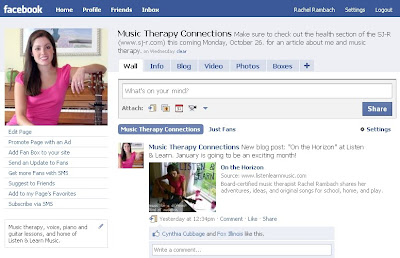 When I joined Facebook as a 21-year-old graduate student back in 2004, I would have laughed at you if you’d told me that one day, my mother and I would be Facebook friends. Fast-forward to five years later, when I am Facebook friends with not only my mother, but her friends, my dad, my former professors, and my students’ parents. Not to mention hundreds of other people from all areas of my life.
When I joined Facebook as a 21-year-old graduate student back in 2004, I would have laughed at you if you’d told me that one day, my mother and I would be Facebook friends. Fast-forward to five years later, when I am Facebook friends with not only my mother, but her friends, my dad, my former professors, and my students’ parents. Not to mention hundreds of other people from all areas of my life.
So thank you to everyone who has taken a moment to “become a fan” of Listen & Learn on Facebook, simply by clicking the Facebook box that appears in the left-hand sidebar of this page. (And if you haven’t already, please do so!) I also wanted to share a few other Facebook pages that you might enjoy:
Brown Music Therapy
The Hope Institute for Children & Families
Kidlutions: Solutions for Kids
Kids Sing Studio
Laurie Berkner Band
Midwest Music Therapy Services
Model Me Kids
Neurosong Music Therapy Services, Inc.
Songs For Teaching
West Music
If you can think of any I might have left out, or you have your own Facebook page that Listen & Learn readers might enjoy, please feel free to share in the comments section or send me an email. Happy Friday, everyone!
On the Horizon
Beginning in January, I will be offering consultative music therapy services through my private practice, Music Therapy Connections. Consultative services, you ask? Though I go into great detail on the MTC website, I’ll sum it up here in just a few sentences.
When a student comes to my studio for one-on-one or group music therapy, that is considered direct service. We work on specified goals and objectives using the songs, activities and interventions I have designed based on that student’s specific needs. However, if I provide the student with those songs, activities, and interventions (as well as accompanying tools for the parent, teacher, or other professional) without meeting face-to-face on a regular basis, then that is considered consultative service.
Several factors played into my decision to offer consultative services. First of all, I love creating and providing resources (which is pretty clear, I hope, based on this blog). The fact that children all over the US and beyond are benefiting from my songs and activities simply amazes me, and I want to take that further. Consultative services allow me to provide individual therapeutic and learning experiences through music on a wider scale; in this way, I am not limited to children in central Illinois. Anyone, anywhere can receive these services as long as communication is available via phone, internet, and (seldomly) snail mail.
Secondly, my direct services are limited to the students I can see between the hours of 4 and 7 pm, as I work at a school during the day. Consultative services are not :) After all, doesn’t everybody need one more way to fill their nights and weekends? The truth is, I love the work that I do and I can’t wait to do even more of it.
And last but not least, I think the interest is there. I receive many emails from parents all over who want to explore music therapy for their children, but do not have a music therapist in their area. And while direct service is the ideal means of delivery, sometimes it just isn’t possible.
Please visit my new Consultative Services page for a more in-depth explanation. I have also put together a list of Frequently Asked Questions, though you are certainly welcome to contact me directly for more information.
The Birthday Song You Haven’t Heard (Part 2)
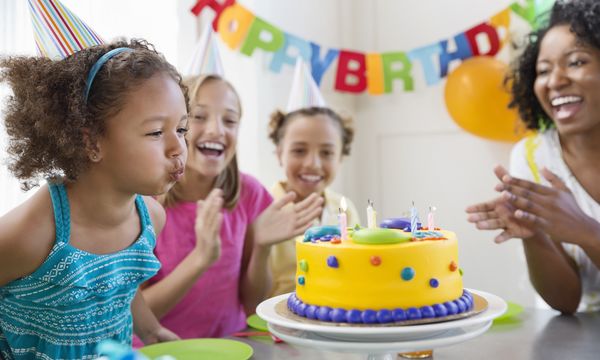
When it comes to ending a music class or music therapy session, I have plenty of goodbye songs from which to choose. But last year for Maggie’s birthday party, I wanted to do something a little different.
So instead of ending the music portion of her party with a goodbye song she already knew, I sang one I wrote especially for her. Thus, the “Birthday Goodbye Song” became a tradition, and I have been using it ever since.
Now it’s time for me to sing my last song.
I’m so glad you came today and sang along.
Thanks so much for joining in and listening too,
I had a wonderful time with all of you!
Music time is over but the party’s just begun,
There’s still so much to do so let’s go have more fun.
Maggie’s turning five so we’re gonna celebrate,
With presents to open and ice cream and cake.
Now it’s time for me to sing my last song.
I’m so glad you came today and sang along.
Thanks so much for joining in and listening too,
I had a wonderful time with all of you!
Short and sweet, because by the time the music portion of a birthday party comes to an end, the birthday girl or boy and guests are getting antsy in anticipation of sugar…lots and lots of sugar. And I don’t mind having a piece of cake and some ice cream, myself!
The Birthday Song You Haven’t Heard (Part 1)
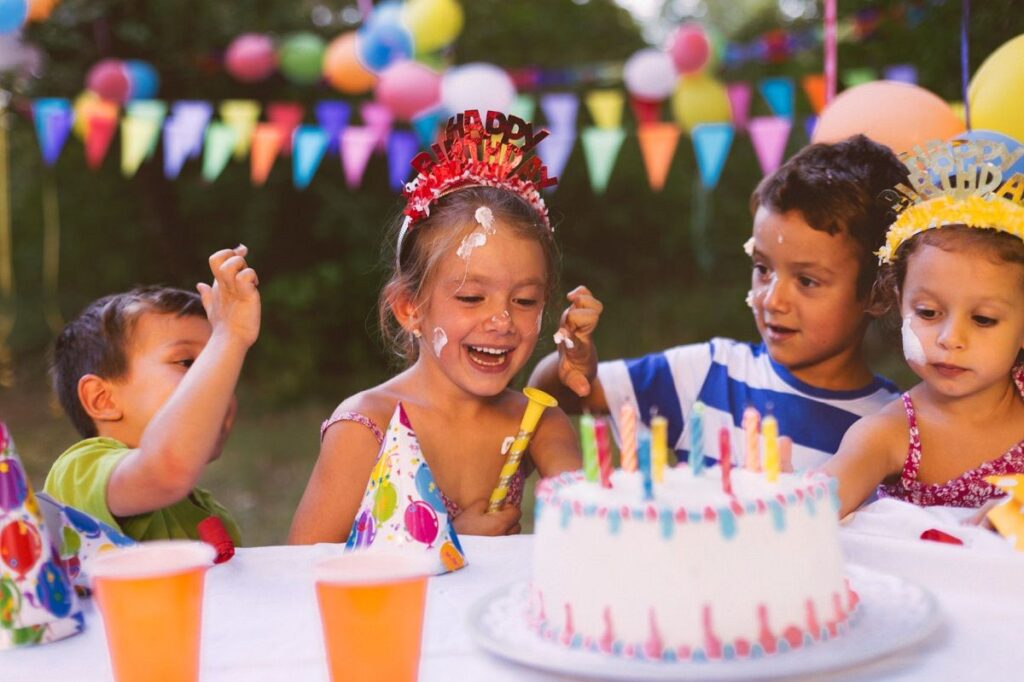
Last year I had the pleasure of helping two of my favorite church mice, Maggie and Samantha, celebrate their birthdays. Not only did I lead music time at both girls’ birthday parties, but I also made them special CDs with some of their favorite songs included.
The girls’ mom has asked for birthday CDs again this year, so I decided to take it one step further. I wrote a personalized birthday song which includes both the name and age of my birthday buddy, in this case, Maggie. I combined my new words and melody with the classic “Happy Birthday” song, which resulted in this:
Doot-do-do, do-do-do
Happy birthday, Maggie!
You are turning five years old.
Celebrate yourself today,
And all the fun this year will hold.
Birthday parties, presents to open,
Cake and ice cream too.
Friends and family come together
And it’s all because of you!
CHORUS
It’s your very special day
So do what you want to do.
Laugh and smile, have a ball.
And may your birthday wish come true!
CHORUS
Happy birthday to you,
Happy birthday to you.
Happy birthday, dear Maggie,
Happy birthday to you!
This tune starts the CD, letting the birthday girl know that it is her very own special song collection. The rest of the playlist includes both favorites recommended by her parents and other Listen & Learn songs I think she might enjoy. There is also a special birthday goodbye song at the end, which again is personalized. Come back tomorrow to hear it :)
Friday Fave: Model Me Kids
Today’s edition of “Friday Faves” is brought to you by Twitter, because that is how I discovered Model Me Kids. Little did I know that many of my students already knew all about Model Me Kids, and used their videos at home.
From their website:
Model Me Kids® is dedicated to producing high quality teaching tools for children, adolescents, and teenagers with Autism, Aspergers, PDD-NOS, Nonverbal Learning Disorder (NVLD or NLD), and developmental delays. The videos are used by parents, teachers, and therapists. They are also helpful for teaching children with developmental disabilities such as Down Syndrome and may be used with typically developing younger children. Model Me Kids® videos demonstrate social skills by modeling peer behavior at school, on a playdate, at a birthday party, on the playground, at a library, restaurant, and more. Real children model and narrate each skill. DVDs for ages 2-17.
Shortly after following Model Me Kids on Twitter, I received an email from Sue Klein, MMK’s founder and president. She had visited Listen & Learn and thought my songwriting style might be a good match for a video they were currently producing. I loved the idea, and immediately called her to tell her so. Creating the music for Model Me Faces & Emotions™ became one of my summer projects, and it was so much fun! But the best part was receiving my copy of the finished DVD just last week. Actually, I take that back…the VERY best part was having my students receive their copies only to discover my picture on the back cover and hear my familiar voice narrating the video :)
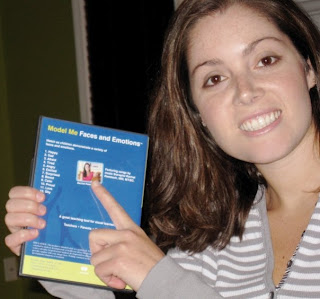
Model Me Kids currently offers 8 DVDs: Model Me Faces & Emotions, Time for School, Time for a Playdate, I Can Do It!, Model Me Conversation Cues, Model Me Friendship, Model Me Tips & Tricks, and Model Me Confidence. You can view samples on their website.
Teaching social skills is a huge focus for the students with whom I work, which made this collaboration truly exciting. If you work with or have children (whether they have autism, another developmental disability, or are typically developing) and want to learn more about Model Me Kids, you can find them on Facebook, Twitter, and their website.
So that does it for today’s Friday Fave. This week has flown by, and I am in disbelief that it is already time for another weekend. I have sheet music to edit, two presentations to prepare, articles to write, and songs to record, but somewhere between that I am going to squeeze in some time with friends. What are your weekend plans?
‘Dem Bones, ‘Dem Bones
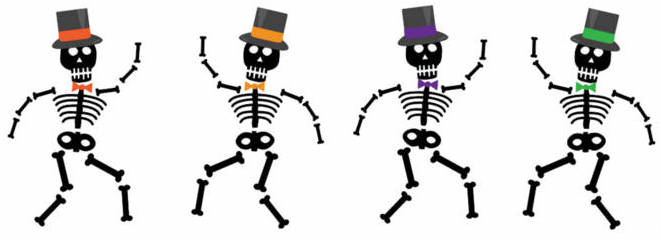
How about a Halloween song that almost everyone knows, or at least has heard once or twice? It’s actually an old spiritual, but over the years has become a staple for this time of year. Most of my students instantly recognize this when I begin singing or playing one of the many versions that has been recorded for children.
My favorite is in the style of a barbershop quartet, and you can find it on the album Wee Sing for Halloween. What’s great about “Dry Bones” is that it doubles as a fun way to work on body part identification.
Dem bones, dem bones, dem dry bones!
Dem bones, dem bones, dem dry bones!
Dem bones, dem bones, dem dry bones!
Oh see dem skeleton bones.
The foot bone connected to the leg bone,
The leg bone connected to the knee bone,
The knee bone connected to the thigh bone,
The thigh bone connected to the back bone,
The back bone connected to the neck bone,
The neck bone connected to the head bone,
Oh see dem skeleton bones.
Dem bones, dem bones gonna walk around,
Dem bones, dem bones, gonna walk around,
Dem bones, dem bones, gonna walk around,
Oh see dem skeleton bones.
The head bone connected to the neck bone,
The neck bone connected to the back bone,
The back bone connected to the thigh bone,
The thigh bone connected to the knee bone,
The knee bone connected to the leg bone,
The leg bone connected to the foot bone,
Oh see dem skeleton bones.
Dem bones, dem bones, dem dry bones!
Dem bones, dem bones, dem dry bones!
Dem bones, dem bones, dem dry bones!
Oh see dem skeleton bones.
I usually pass out rhythm sticks for this song, and yesterday, one of my students did the cutest, most clever thing with them. She made a “skeleton” out of an entire tub of sticks, and then pointed to each different “bone” as it was sung. Seriously, these kids never cease to amaze me.
Time to Say Goodbye

Goodbyes aren’t easy. There’s nothing fun about parting with a relative or friend, whether its for a few short days or for an extended period of time. But if saying goodbye is difficult for you, think about how it must feel for a child who has severe separation anxiety issues. Many of the children I work with must deal with this on a daily basis, and that is one of the things we can address during music therapy.
We always end our sessions with a goodbye song, and I try to stick with those that are happy and upbeat so that the transition to the next activity is hopefully a positive one. However, I wanted to address the feelings that some children associate with saying goodbye, which is why I wrote this particular song.
In the morning when I go to school,
It’s time to say goodbye.
To the people I’m leaving, like mom and dad,
It’s time to say goodbye.
Goodbye means only ’til next time,
To the people I’ll see again soon.
Sometimes goodbyes are hard for me,
So I’ll say goodbye with a tune.
In the afternoon when I go home,
It’s time to say goodbye.
To the people I’m leaving, like teacher and friends,
It’s time to say goodbye.
CHORUS (2x)
It’s important to validate the anxious or sad feeling a child may experience when he or she says goodbye, and reassure that it is only a temporary separation (except in the case of death, which is a completely different subject I will be addressing soon).
This song could be used at different transition times throughout the day; I mentioned going to school and coming home from school, but you could easily add verses about going other places or seeing off a friend or loved one for a period of time.
And now I must say goodbye to you! Wednesdays are very busy here at The Hope Institute, and my first of five group sessions begins soon. Have a wonderful day :)

